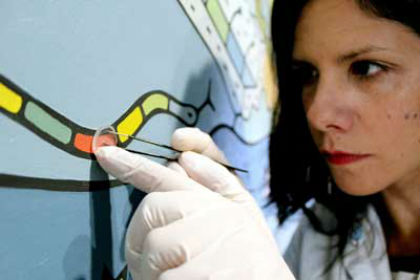|
NOVIDADES
Three articles published recently in the framework of the European Project ‘NanoRestArt’ endorse the new, fast and non-invasive diagnostic tool developed at CiQUS for the conservation of artworks, capable of detecting signs of degradation in oil paintings and plastic-based sculptures.  The new diagnostic tool allows alerting about risks of degradation in sculptures and oil paintings. Photo: Andrés Ruiz/CiQUS
In the art sector material loss is not an exception. The oxidation phenomenon rarely can be separated from the creative process, where frequently organic materials are employed in different disciplines. The oil paint technique itself is based on the combination of oils derived from plants with pigments. Similarly, contemporary art sculptures made out of polymers (plastics), known for their rapid decay, are already displaying alarming signs of early degradation. Currently, the strategy followed by conservators and museums to avoid and minimize damages is focused on preventive conservation measures, through monitoring and documentation of the deterioration risks affecting the artworks. However, the methods to determine the ideal timing to proceed with restoration interventions are still too rudimentary and invasive, since consistent material sampling for subsequent analysis is required, implying potential minor or major damage for the artifacts. A newly developed ‘diagnostic kit’ that allows to address if an artwork is showing symptoms of deterioration and premature ageing, detecting degradation markers, is presented in the papers published by the group led by CiQUS Principal Investigator Massimo Lazzari. The most relevant feature of the kit is the noninvasiveness of the sampling, so that there is no harm for the artwork. “In a context as fragile as that of art”, says Professor Lazzari, “is extremely important to have achieved a new tool to take samples with no damage on the artwork surface: no fragments destruction is involved to assess the conservation conditions”. More precisely, the work published in the Chemical Communications journal ("Surface enhanced Raman scattering (SERS) in the visible range on scalable aluminum-coated platforms") describes the theoretical development of a substrate for the analysis of samples through the SERS spectroscopy (Surface Enhanced Raman Scattering), thanks to which the new tool was being validated. The authors show the procedure followed for the fabrication of disposable polymeric substrates, obtained through soft lithography and coated with aluminum, and explain their functioning. A number of techniques have been used, including the characterization through EELS (Electron Energy Loss Spectroscopy), carried out in the Centre for Electron Microscopy of the Technical University, in Denmark. The other two papers tackle the applications of the new diagnostic kit. The first has been published in the Journal of Raman Spectroscopy ("Linseed oil as a model system for surface enhanced Raman spectroscopy detection of degradation products in artworks") and demonstrates the application of the method on oil paintings (as it can be seen in the open access video linked to the article). Concurrently, in a second paper published in the journal Talanta ("Detection of degradation markers from polymer surfaces by a novel SERS-based strategy"), the efficiency of the analytical techniques proposed is validated on model plastic materials, as well as on plastic artworks. CiQUS. Posted: Oct 03, 2018. |
|||||||||||||||||||||||||